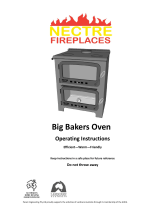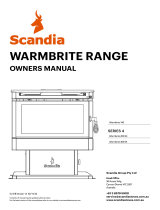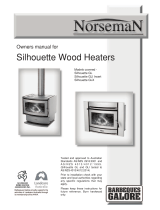4
1.8. ASH REMOVAL
Depending on the type of wood burnt and frequency, the
ashes will need removing every 2 to 6 weeks.
Excess ashes should be removed when necessary, placed
in a non-combustible container such as the ash pan
beneath and moved outdoors immediately to a location
clear of combustible materials.
Leave a small amount of ash, approximately 10mm thick,
in the bottom of the firebox. This helps to insulate the base
of the firebox.
1.9. FLUE/CHIMNEY FIRE
If a flue/chimney fire occurs:
• Shut air slide fully to smother the fire.
• Do not use the appliance after a flue fire until an
accredited installer has assessed the cause and any
resultant damage.
1.10. CLEANING PAINT WORK AND GLASS
• The appliance, when cool, can be cleaned with a damp
cloth.
• Over the years, the black paint will fade and can be
touched up with Stove Bright metallic black paint.
• To clean the glass, we recommend using a household
window cleaner or general purpose cleaner with a soft
cloth.
Do not use abrasive cleaner or scourer pads.
1.11. CLEANING THE FLUE
Check inside of flue prior to each season for any build-up of
creosote (wood tar).
To check the flue:
1) Remove the baffle plates (refer to ‘Replacing the Baffle
Plates’ under Maintenance & Servicing).
2) Hold a small mirror on an angle below the flue, with a
torch shining towards it, and look for black creosote
build-up. It is normal to see a fine black powdery layer,
but if built up layers of creosote can be seen, the flue
requires cleaning.
3) If no cleaning is required, re-fit the baffle plate.
To clean the flue:
1) A flue cleaning brush can be purchased from most wood
heater retail outlets or large hardware stores.
Alternatively, hire a flue cleaning service to do the job for
you (it’s a dirty job).
2) With the baffle plates removed, tie a rope to one end of
the brush, and drop the rope down the flue (from outside
on top of the roof).
3) Grab the end of the rope from inside the firebox and pull
the brush down through the flue.
4) Check the inside of the flue with the mirror and torch.
5) Repeat cleaning process if necessary.
6) Once the flue is clean, remove any excess creosote from
the firebox.
7) Replace the baffle plate.
Only pull brush downwards through flue, as pulling upwards
may separate the flue sections at their joins.
1.12. TROUBLESHOOTING TIPS
1. Glass in door blackening
This can have several possible causes:
i) Burning unseasoned wood — if the wood is too
wet, it will cause the glass to blacken.
ii) Appliance operated at low temperature — after
an overnight burn where the air slide control
has been fully closed, the glass may have
blackened. When the fire is re-stoked and
burning on the high heat setting, the blackened
glass should self-clean.
iii) Problems with the flue — insufficient flue
draught can cause the glass to blacken. If the
flue is too short, not properly insulated, or in a
position that results in a downdraught, then
there will be insufficient flue draught. Contact
the installer should this happen.
2. Trouble starting the fire — if all ash has been
removed from the firebox, then it can upset the
supply of air to the base of the fire. It can aid the fire
by retaining some ash when cleaning out the firebox.
3. Glass cracking — Do not over tighten the screws on
the retainer that holds the door glass in place.
Otherwise, expansion of the door may cause the glass
to crack.
















